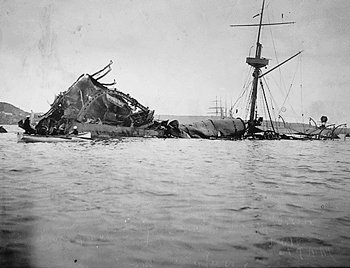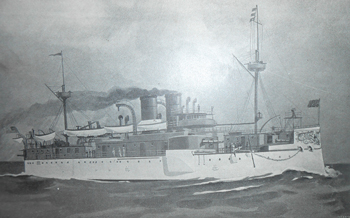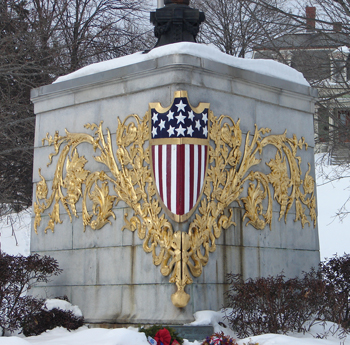Remember the Maine
The Sinking of the Battleship Maine
By Tom Seymour

The Maine was sunk at a mooring in Havana Harbor on February, 8, 1898. The explosion(s) in the forward munitions and coal bunkers piled the wreckage visible in this photograph. Naval personnel can be seen rowing past in the foreground, left. One of the Maine’s two smokestacks lies crumpled on the deck center. Square rigged vessel’s masts are visible in the background. NARA photo
Who hasn’t heard the rallying cry, “Remember the Maine?” And as a constant reminder of the ill-fated, American battleship, the original scroll and shield stands mounted on a life-size replica of her bow in Bangor’s Davenport Park.
The Spanish-American War, or as it was known at the time, “America’s War With Spain,” seems out of sight and out of mind for most people. And yet, it was only in the last decade or so that a tax on our telephone bills, placed there to pay for the costs of the war, was abolished.
And as much as people remember Teddy Roosevelt and his Rough Riders, it is the sinking of the Battleship Maine in Havana Harbor on February 15, 1898, that resounds the loudest. But what was the Maine doing there, and what caused its destruction? The former is easily answered, the latter requires more discussion.
It was always a matter of course for United States warships to make friendly visits to ports of all the countries of the world. Up until the outbreak of the Cuban Revolution early in 1895, U.S. ships of war were frequent visitors to Cuban ports. But when the revolution broke out, prompted by Spain’s mistreatment of Cuban nationals, President Cleveland suspended these goodwill visits for fear that Spain would view it as threatening to their authority.
Cleveland’s successor, President McKinley, however, reversed his predecessor’s policy and contacted Spanish authorities, telling them of his decision. McKinley wanted U.S. ships to once again visit Cuban ports as a gesture of good will. Spain agreed and even offered to send Spanish ships to U.S. ports as a sign of their wish for continuing peace.
And so it was that the battleship Maine entered the harbor at Havana on January 24, 1898. Spanish authorities were aware of the Maine’s mission and greeted her with salutes and ceremonial visits.
Not everyone viewed the Maine’s visit to Havana as a simple courtesy call, though. It was plain to everyone in America, Cuba and Spain that United States interests, including not only commercial interests but also American citizens, were imperiled because of the ongoing insurrection and the steadily-eroding attitude of Spain toward America.
The Maine’s presence in Cuba signaled different things to different people. The Cubans saw it as evidence of American sympathy for their cause. American citizens believed that the Maine’s visit to Havana was a sign of a changing attitude of the national government toward Spain’s growing threat to American lives and property and the Spanish people regarded the Maine’s presence as a real threat to Spain and a sign of America aligning with the Cuban insurgents.
Virginius Massacre
Tension between the United States and Spain was nothing new. Twenty-five years prior to the Maine coming to Havana, the Spanish gunboat Toledo, after an eight-hour chase, captured the United States-registered sidewheel steamer Virginius. Originally put in service as a Confederate blockade-runner during the U. S. Civil War, the Virgin was captured by a U.S. vessel. In 1870 she was sold to an agent of the Cuban junta (this was during an earlier Cuban revolution, 1868 through 1878), her name changed to Virginius and put to use as a “filibuster,” a term then used for speedy, blockade runners.
The Virginius was the most daring of her class and made numerous landings in Cuba, delivering arms and supplies to the insurgents. But she had seen the last of her filibustering upon being taken by Spain.
The Virginius was, despite her never being berthed in United States waters, a vessel of U.S. registry, with an American captain and a crew composed of a mixture of American and Cuban citizens. Despite showing her American papers and American colors, the Virginius’ captain was told that his ship was a pirate ship and her flag was torn down and replaced with a Spanish flag.
Immediately upon reaching Santiago de Cuba, all 155 men from the Virginius were thrown in prison and a court martial was immediately convened. Most of the prisoners were condemned to death by firing squad and the first executions took place on November 4. The four victims included a British citizen. The men were shot, beheaded, their heads displayed on pikes and their torsos trampled by horses.
More executions took place on November 8, followed by 37 more being executed on November 13. Among the 37 were the officers and crew of Virginius, along with American citizens. The outcome of this was a near-war situation, with actual hostilities being averted only by extreme diplomacy. And yet, Americans never forgot the Virginius incident. With this background in mind, we return to the Maine’s visit to harbor at Havana.

Illustration of the US Battleship Maine. When an explosion sank the Maine in Havana Harbor in 1898, 266 lives were lost, 200 were recovered and 76 were identified. A confirmed cause of the explosion has not been established. Laid down by New York Naval Ship Yard on October 17, 1888. (More Maine specs at fishermensvoice.com)
Tremendous Explosion
The Maine entered Havana Harbor at sunrise on January 25, 1898, and met the harbormaster, who directed her to a specified anchoring place. Three weeks later, at 9:40 p.m. on February 15, the battleship was rocked by a terrific explosion which destroyed the entire forward portion of the ship. This had the effect of killing 264 crew members and 2 officers. Those who were not immediately killed as a result of the blast were trapped in the twisted wreckage and drowned when the hull immediately sank.
Spanish authorities reacted by opening all area hospitals to survivors. Neighboring vessels as well as ship’s boats of the Spanish cruiser Alphonse XII rendered immediate aid. The Spanish offered tributes and great sympathy for the victims of the disaster.
Not forgetting the tragedy of the Virginius, the American people immediately blamed Spain for the Maine’s destruction. However, the American government laid no responsibility on anyone and instead, proceeded with caution, launching a Naval Court of Inquiry. This also allowed for a similar course of investigation by the Spanish. The Spanish investigation, to no one’s surprise, did not blame Spain for the Maine’s sinking.
The American Court of Inquiry released its findings on March 21. One of its conclusions, duly transmitted to President McKinley read: “The state of discipline on board and the condition of her magazines, boilers, coal bunkers and storage compartments are passed in review, with the conclusion that excellent order prevailed and that no indication of cause for an internal explosion existed in any quarter.”
The court also concluded that: “The loss of the Maine was not in any respect due to fault or negligence on the part of any of the officers or members of her crew; That the ship was destroyed by the explosion of a submarine mine, which caused the partial explosion of her forward magazines; and that no evidence has been obtainable fixing the responsibility for the destruction of the Maine upon any person or persons.”
On March 21, the House passed a bill for the relief of survivors and victims of the Maine tragedy. Surviving officers and men were awarded an amount not to exceed one year’s sea pay and a sum equal to one year’s pay was awarded to legal heirs of dead victims.
Spain Blamed
So while the Naval Court of Inquiry did not assign blame for sinking the Maine on Spain or any other entity, the American people were not of a similar train of thought. In the minds of the average citizen, the responsibility for the brutal and unprovoked explosion that sunk the Maine lay squarely upon the shoulders of the Spanish government.
The April 14 issue of the popular magazine Leslie’s Weekly contained strong language blaming Spain. “The Maine was in a Spanish harbor on a peaceful errand. Its location was fixed by the Spanish authorities, and if a mine was planted in the harbor, it could have only have been planted by the Spaniards.”
The Spanish government, however, was conciliatory and told President McKinley that it would, “do all that the highest honor and justice required in the matter of the Maine.” Spain also consented to arbitration by in impartial body, the result of which Spain would accept in advance.
Despite all this, feelings ran high and war began with Congress authorizing the President of the United States to call the United States Army and Navy into service.
Maine Revisited
The Naval Board of Inquiry’s findings did not put a rest to speculation as to the cause behind the Maine’s destruction. Indeed, it only marked the starting point of what would continue, unabated, until the present time.
Immediately upon learning the official government stance on the cause, various groups and individuals began offering their own opinion. Speculation ran rampant, and for good reason. There were numerous possibilities and these weren’t mentioned in the official report.
Might the mine that caused the external explosion have been planned by Spain? The Maine’s mooring might have had a submerged mine floating just for that purpose. It took three weeks for the ship and the mine to connect.
Or, was a mine planted by a saboteur? There were many reasons why an individual or group would wish to destroy an American ship. Even the Cuban rebels themselves were viewed with a jaundiced eye. After all, there was no doubt that an attack on the Maine would inflame America’s ire against Spain and thus bring America into the conflict. On and on it went.
And there were those who were firmly planted in the internal explosion camp. Although the official investigation declared that this was not a possibility, it was known that coal-burning ships were at risk of fire from spontaneous combustion of the bituminous coal used as fuel. And this coal was often stored close to the magazines of steam-powered battleships.
A slew of other internal causes were bantered about. Fire in the magazine itself, fire from flammable liquids and actual sabotage by someone aboard.
Those in the external explosion camp were upheld in their stance by reports from those aboard at the time who affirmed that they definitely heard two explosions. This would make sense, the outside explosion from the mine being the trigger to set off a secondary, larger explosion.

The Battleship Maine crest and shield in Davenport Park. Davenport Park is at the corner of Main and Cedar Streets in downtown Bangor, Maine. Tom Seymour photo
Second Investigation
In 1910, Congress authorized the raising of the Maine. This was in response to citizens calling for the victim’s remains being brought back home to America. Also, the Maine’s wreck posed a hazard to shipping and Cuba wanted it removed. So the U.S. Army Corps of Engineers tackled the project. They built a cofferdam around the Maine, which allowed them to pump out water, leaving the Maine exposed to the air and in a much better position for further investigation into the cause of the explosion.
The remains of the dead heroes were removed from the Maine for burial in Arlington National Cemetery. Water was then let into the cofferdam, the Maine refloated and, towed out to sea where with much ceremony, she was scuttled.
The Vreeland Board of 1911, after thorough perusal of the Maine’s remains, concluded, as did the first board of inquiry, that the Maine was the victim of an external blast. But that still didn’t explain who was responsible for the blast.
The idea that Spain was directly responsible for sinking the Maine was accepted by most of the world, including the Cuban people. Cubans, until Fidel Castro came to power in 1959, believed that Spain was responsible for the explosion and that Cuban independence was a result of United States intervention in the cause of Cuban freedom. But Castro changed the plan and rewrote history, declaring that the United States deliberately blew up its own war ship, placing blame on Spain in order to justify its actions in Cuba.
Then in 1974, Admiral Hyman G. Rickover initiated a private investigation into the cause of the sinking of the Maine. His investigation, using records and information from previous investigations, concluded that spontaneous combustion of coal very close to the magazine was the culprit.
Private investigations continued. In 1998, National Geographic Magazine launched its own investigation. This time, investigators used computer models. The models indicated that a depression on the sea floor beneath the Maine’s hull was indicative of a mine explosion. Others, including experts from Admiral Rickover’s team, disagreed.
Finally, in 2002, the History Channel got into the act, presenting a documentary called “Death of the U.S.S. Maine.” This used photos, history and naval experts and original information from the archives. The History Channel concluded that the explosion was caused by a fire in the coal bunker.
Given the continuing interest in what actually brought down the Maine, it seems likely that other investigations into the cause of the explosion will be forthcoming. Officially, nobody knows for sure what caused the explosion. And so the sinking of the Maine goes into the realm of folklore and conspiracy theories, right along with the Lincoln and Kennedy assassinations.
Maine Specifications
The Maine was 324 feet, 4 inches long, had a beam of 57 feet, a maximum draft of 22 feet, 6 inches and a displacement of 6,682 tons.
View more Maine specs and photos here.
